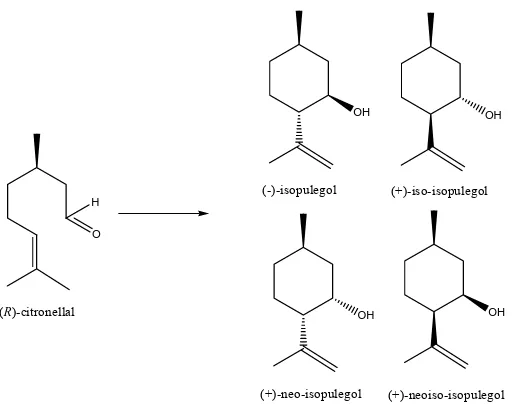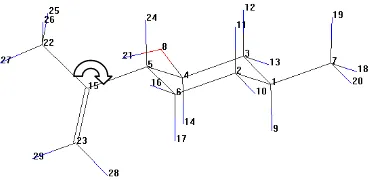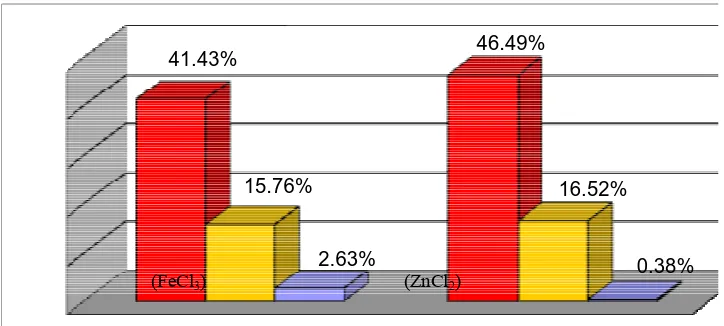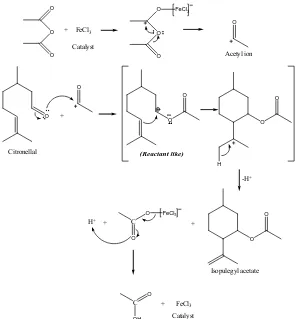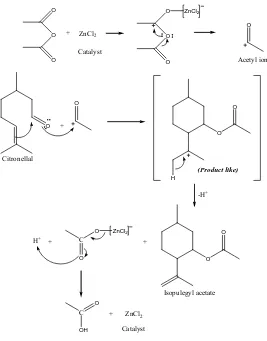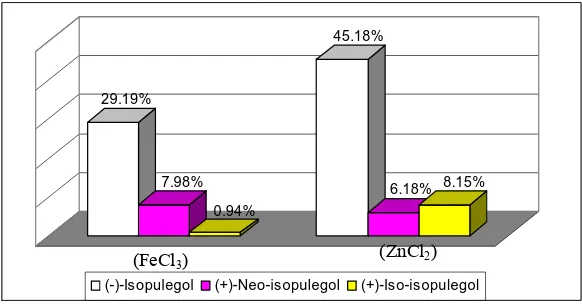1
International Seminar on Chemistry, October 30-31th 2008
SYNTHESIS OF PULEGOL FROM PULEGYL ACETATE
Jamaludin Al Anshori. 1*, Muchalal 2, and Sutarno 2
a
Chemistry Department, Faculty of Mathematics and Natural Sciences, Universitas Padjadjaran, Jl. Singaperbangsa No 2 Bandung 40133 West Java, Indonesia
b
Chemistry Department, Faculty of Mathematics and Natural Sciences, Gadjah Mada University, Yogyakarta 55281, Indonesia
*
Tlp. +6222-2507874, +628122454891, Fax. +6222-2507874, E-mail: [email protected]
ABSTRACT
Synthesis of pulegol from pulegyl acetate has been carried out started from citronellal as precursor that achieved by vacuum distillation of citronella oil, and then refluxed it with anhydride of acetic acid catalyzed by Lewis acid followed by hydrolysis of the product in alcoholic KOH. Structure elucidation of the products was determined by GC-FID, GC-MS, FTIR, and 1H-NMR evidences. Isomers identification was determined by computational simulation. All experimental results were compared to the available literature. Cyclization of citronellal with anhydride of acetic acid catalyzed by Lewis acid FeCl3 yielded 60% mixture of (-)-isopulegyl acetate, (+)-neoisopulegyl
acetate, (+)-isoisopulegyl acetate with ratio of 16:6:1 while 63% mixture of (-)-isopulegyl acetate, (+)-neoisopulegyl acetate, (+)-isoisopulegyl acetate with ratio of
122:43:1 was obtained over Lewis acid ZnCl2. Hydrolysis of pulegyl acetate (catalyzed
by FeCl3) refluxed in KOH/alcohol gave 38% mixture of (-)-isopulegol,
(+)-neoisopulegol, (+)-isoisopulegol with ratio of 62:17:2, and 59.5% with ratio of 15:2:3 due to pulegyl acetate (catalyzed by ZnCl2) hydrolysis products.
Key words: citronella oil, citronellal, isopulegol, isopulegyl acetate, hydrolysis
INTRODUCTION
Indonesia had exported 173.294 tons of citronella oil in 2002 to Europe, America, Japan, India, Taiwan, Singapore, and The middle East which total commodities was US$ 1.150.393. The highest exporting volume was reached in 1975-1980 by 57% of citronella oil in the world (4000 tons/year) [1].
2
International Seminar on Chemistry, October 30-31th 2008
spectrophotometer, and 1H-NMR: α-pinena, limonene, linalool, citronellal, citronelol, geraniol, citronelil acetate, -cariophilena, and elamol [3].
Citronellal and geraniol derivative compounds likes hydroxy citronellal, synthetic menthol, geraniol ester and citronelol ester have been used in perfumery, flavor, fragrance, drugs, and repellent manufacturing for long time. Meanwhile crude citronella oil was used directly as Top/middle Note in home and personal care due to relaxation effect, antiseptic, repellent, limbering up muscle and the odor which can awake enthusiasm [4].
High demands of citronellal and geraniol derivative compounds have encouraged scientist to develop simple and stereoselective synthesis method. This research conducted to converse citronella to pulegol by (1) citronellal isolation from citronella oil, (2) cyclization of citronellal to pulegyl acetate, (3) hydrolysis of pulegyl acetate to pulegol.
Intramolecular cyclization could be initiated by mixing citronellal with HCl, H2SO4, anhydride acetic acid, activated acid Al2O3, zeolite, bentonit, and even with
activated clays. The product was isopulegol as precursor of menthol through Raney-Ni catalytic hydrogenation [3, 5].
Based on Chuah et al. [6] investigation, Zirconium hydroxide and zirconium phosphate catalyst have good activity and selectivity toward citronellal cyclization to isopulegol. Lewis and Bronstead acid sites catalyst was very essential for this reaction.
Iftitah has synthesized isopulegol from citronellal catalyzed by Zn/ -Alumina in methanol. The yield was 95,48% which stereoselectivities 63,87% to (-)-isopulegol [7].
Maki-Arvela, et al. [8] has found that zeolit and mesoporous materials behaved good catalytic activity for citronellal cyclization toward isopulegol in cyclohexane under nitrogen atmosphere. Each isopulegol isomer stereoselectivity was controlled by stability of isopulegol protonated intermediate, and meanwhile the concentration of Lewis and Bronstead acid, and the surface of catalyst had only minor effect.
Isopulegyl acetate was an ester which can be hydrolyzed by acid or base toward isopulegol C10H18O (relative mass 154) as major product. Isopulegol had refractive
3
International Seminar on Chemistry, October 30-31th 2008
(R)-citronellal catalyzed by Lewis acid were (-)-isopulegol (I), (+)-neo-isopulegol (II), (+)-iso-isopulegol (III), (+)-neoiso-isopulegol (IV) (Figure 1).
OH
(-)-isopulegol
OH
(+)-iso-isopulegol
OH
(+)-neo-isopulegol
OH
(+)-neoiso-isopulegol
O H
(R)-citronellal
Figure 1 Stereoisomer structures of pulegol from R-citronellal
Pulegyl acetate and pulegol compounds classified as simple six member ring organic compound. Physical constant of these compounds can be calculated practically by semiempiric method. PM3 semiempiric method was designed to generate formation energy and geometric structures of mostly organic molecules. The absolute error of PM3 method was more acceptance then AM1 and MNDO method.
METHOD
Materials
The materials of this research were citronella oil (Toko Sari Warna Jogjakarta), Iron(III)chloride (FeCl3.6H2O), anhydride acetic acid ((CH3CO)2O), n-hexane, sodium
sulphate anhydrate (Na2SO4), potassium hydroxide (KOH), redistillated ethanol 96%,
technical sodium chloride (NaCl), redistillated methanol, nitrogen gas, silicon vaselin, pH universal indicator.
Apparatus
4
International Seminar on Chemistry, October 30-31th 2008
6000), polarimeter (E-Hartnack Ritter Germany), refractometer (AB-Refractometer Nar-1T), hot plate magnetic stirrer (Cimarec 2 Termolyne), heating mantle, glass laboratory apparatus and computer with computational software.
Procedures
Isolation of citronellal from citronella oil
Citronella oil was analyzed by GC-MS to determine its composition. Citronellal as the major component isolated by fractional distillation under reduced pressure from 250 mL citronella oil. All fraction were separated each other according to liquid-vapor equilibrium temperature and analyzed by GC-FID. The crude of citronellal purified by redistillation and the product identified by GC-MS, FTIR dan 1H-NMR.
Citronellal cyclization toward pulegyl acetate
Lewis acid FeCl3 1,72 gram (10 mmol) and 7,2 mL (120 mmol) anhydride acetic
acid were stirred at room temperature in three neck round bottom flask equiped by condensor, and then 7,0 mL (60 mmol) of citronellal was droped continuously under nitrogen atmosphere. Mol ratio of citronellal, anhydride acetic acid and FeCl3 were
6:12:1.
The crude product partitioned by 10 mL H2O and 10 mL n-hexane after 3 hours
reaction. The organic layer was separated from aqueous phase, netralized by H2O and
finally dried by pottasium sulphate anhydrate. Cyclization product was identified by GC-FID, GC-MS, FTIR, and 1H-NMR.
In addition some experiments over ZnCl2 were carried out under the same
method, which amount of ZnCl2, anhydride acetic acid, and citronellal were 1,36 g, 11
mL and 11 mL respectively. The reaction conducted at 80 oC and the Cyclization product was elucidate by GC-FID, GC-MS, FTIR, and 1H-NMR.
Pulegyl acetate hydrolysis
Pulegyl acetate produced previously as much as 4 g were hydrolized by 25 mL KOH 0,5 N in ethanol. The mixed reaction refluxed for 3 hours at 80 oC, and then partitioned in separatory funnel with 10 mL of diethyl eter and 10 mL of H2O. The
Organic layer was separated from aqueous phase, netralized by H2O and finally dried by
5
International Seminar on Chemistry, October 30-31th 2008
Isolation of hydrolysis product
The crude of hydrolysis product as much as 20 mL was separated by fractional distillation under reduced pressure, and purified pulegol was obtained according to liquid-vapor equilibrium temperature and identified by GC-MS, FTIR and 1H-NMR.
Computational chemistry for determining reaction stereoisomer
Molecular geometry optimation was calculated by semiempiric PM3 method. The most stable structure determination was conducted through systematical searching which means conformation considering based on torsion angle. The torsion angle of C22-C15-C5-C6 bond was turned around every 10o for 36 times (Figure 2). Each
constructed conformation optimazed in order to find the most stable conformation with the lowest energy.
Figure 2 Rotation direction of angle torsion in finding of conformation which the nearest to minimum global energy.
RESULTS AND DISCUSSION
Isolation of Citronellal from Citronella Oil
Fractional distillation under reduced pressure of 250 mL citronella oil at 110-115oC/2,5 cmHg yielded 45% citronellal in second fraction (±112,5 mL). Citronellal was obtained up to 89,82% after being redistilled under the same condition. The physic properties of isolated citronellal were
[ ]
α 27D +8,35o
, [
ρ
27] 0,8570 g/mL, and [η20]1,4478, meanwhile standard citronellal (E.Merck) had physic properties
[ ]
α
27D +3,80o ,
[
ρ
27] 0,8469 g/mL, and [η20] 1,4373. A direct comparation between two data of those6
International Seminar on Chemistry, October 30-31th 2008
Citronellal Cyclization toward Pulegyl Acetate
Citronellal cyclization was conducted over two Lewis acid catalysts at different reaction temperature. First cyclization was carried out between isolated R-citronellal 89%, anhydride acetic acid, and FeCl3 at room temperature under nitrogen atmosphere
during 3 hours, and the second cyclization was observed over ZnCl2 at temperature 80 o
C under same condition. The ratio of stereoisomer pulegyl acetate product due to FeCl3
was 16:6:1, meanwhile for ZnCl2 was 122:43:1(Figure 3). Differences of the ratio could
be comprehended by their own physical properties and reactivities. Lewis acid FeCl3
more reactive than ZnCl2.
Hammond postulate stated that reactive reagent (exothermic) would generate reactant like intermediate while selective reagent (endothermic) would generate product like intermediate. These intermediate compounds were the determining rate step. According to this postulate, the determining rate step of citronellal cyclization to pulegyl acetate (FeCl3 catalyst) would be reactant like and for ZnCl2 catalyst would be
product like. Cyclization mechanism presented in figure 4 and 5.
41.43% 46.49%
15.76% 16.52%
2.63% 0.38%
Figure 3 Percentage of pulegyl acetate stereoisomer cyclization product over catalyst FeCl3 (T room) and ZnCl2 (T 80 oC)
Pulegyl Acetate Hydrolysis
Ester of pulegyl acetate was hydrolyzed to pulegol and acetic acid. The reaction mechanism were predicted as described in Figure 6. According to peak sequences of (-)-isopulegol, (-)-neo-isopulegol and (-)-iso-isopulegol the stereoisomer ratio of hydrolysis products was presented in Figure 7.
7
International Seminar on Chemistry, October 30-31th 2008
Hydrolysis of pulegyl acetate (catalyzed by FeCl3) refluxed in KOH/alcohol
gave 38% mixture of (-)-isopulegol, (+)-neoisopulegol, (+)-isoisopulegol with ratio of 62:17:2, and 59.5% with ratio of 15:2:3 due to pulegyl acetate (catalyzed by ZnCl2)
hydrolysis products. The first product ratio was more stereoselective to (-)-isopulegol than the second ones, although it had lower yield than the first one.
The facts that (-)-isopulegol product more abundance then (+)-neo-isopulegol and (+)-iso-isopulegol was being able to be comprehended by total energy of pulegol stereoisomer formation simulated by computational method over Hatree-Fock (HF) basis 6-31 +G approach with software Gaussian 98 [8].
O
8
International Seminar on Chemistry, October 30-31th 2008 O
Figure 5 Intramolecular cyclization mechanism of citronellal with anhydride acetic acid over ZnCl2 catalyst
9
International Seminar on Chemistry, October 30-31th 2008
Figure 7 Pulegol stereoisomer ratio as pulegyl acetate hydrolysis product (FeCl3 and ZnCl2 catalyst)
Isolation of Hydrolysis Product
Pure pulegol was isolated from 20 mL of pulegyl acetate hydrolysis product by fractional distillation under reduced pressure at 80-90 oC/2,5 cmHg. The purified pulegol was found in second fraction. Chromatography gas showed that the isolated pulegol content was 76,86% with isomer ratio (-)-isopulegol: (+)-neo-isopulegol: (+)-iso-isopulegol due to 31,7:1:8,8.
Computational simulation over semiempiric PM3 method (Table 1) showed that total energy of (-)-isopulegol formation was the lowest among two other pulegol isomers. As the consequences (-)-isopulegol was the most stable and abundance among other isomers.
Table 1 Total energy of Formation and dipole moment of three pulegol isomers simulated by semiempiric PM3 method
Pulegol Energy (ccal/mol) Dipole Moment (Debyes)
(-)-Isopulegol -40523,065 1,506
(+)-Neo-isopulegol -40522,119 1,614
(+)-Iso-isopulegol -40521,916 1,500
29.19%
7.98% 0.94%
45.18%
6.18% 8.15%
(-)-Isopulegol (+)-Neo-isopulegol (+)-Iso-isopulegol
10
International Seminar on Chemistry, October 30-31th 2008
CONCLUSIONS
1. Cyclization of citronellal with anhydride of acetic acid catalyzed by Lewis acid FeCl3 yielded 60% mixture of (-)-isopulegyl acetate, (+)-neoisopulegyl acetate,
(+)-isoisopulegyl acetate with ratio of 16:6:1 while 63% mixture of (-)-isopulegyl acetate, (+)-neoisopulegyl acetate, (+)-isoisopulegyl acetate with ratio of 122:43:1 was obtained over Lewis acid ZnCl2.
2. Hydrolysis of pulegyl acetate (catalyzed by FeCl3) refluxed in KOH/alcohol gave
38% mixture of (-)-isopulegol, (+)-neoisopulegol, (+)-isoisopulegol with ratio of 62:17:2, and 59.5% with ratio of 15:2:3 due to pulegyl acetate (catalyzed by ZnCl2)
hydrolysis products.
ACKNOWLEDGMENTS
The authors would like to extend their sincerest gratitude to my research supervisor. In addition, we would like to express much appreciation to the director and staff of Universitas Padjadjaran I-MHERE project for funding and supporting in this work.
REFERENCES
[1] Wahyuni, S., Hobir, dan Nuryani, Y., 2003, Perkembangan Teknologi TRO Vol. XV, No 2: Status Pemuliaan Tanaman Serai Wangi, Balitro.
[2] Sastrohamidjojo, H., 2006, Produk Turunan Minyak Atsiri dan Potensi Pasar, Konferensi Nasional Minyak Atsiri 2006, Solo.
[3] Sastrohamidjojo, H., 1981, Study of Some Indonesian Essential Oil, Disertasi S3 FMIPA UGM, Yogyakarta.
[4] Sabini, D., 2006, Aplikasi Minyak Atsiri pada Produk Home Care dan Personal Care, Konferensi Nasional Minyak Atsiri 2006, Solo.
[5] Priatmoko, 1990, Sintesis Mentol dari Sitronelal Hasil Isolasi dari Minyak Sereh. Tesis FMIPA UGM Jogjakarta.
[6] Chuah, G.K., Liu, S.H., Jaenicke, S., and Harrison, L.J., 2001, Cyclisation of Citronellal to Isopulegol Catalysed by Hydrous Zirconia and Other Solid Acids, J. Catal., 200:352-359.
11
International Seminar on Chemistry, October 30-31th 2008
